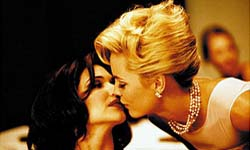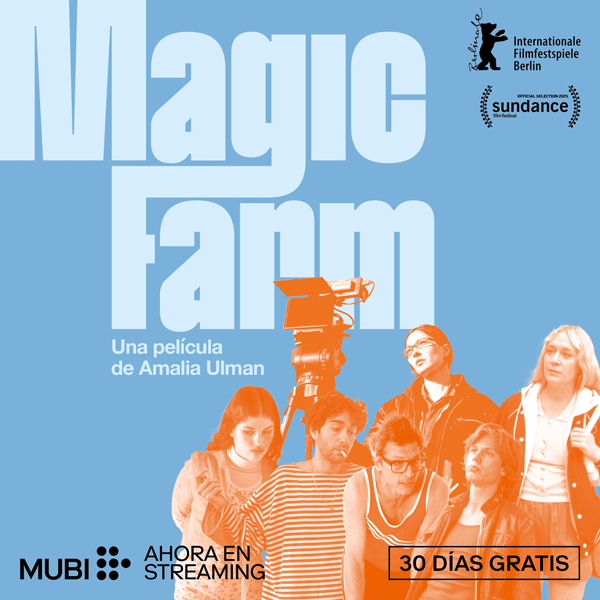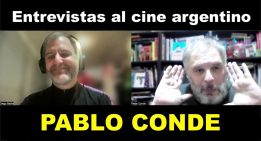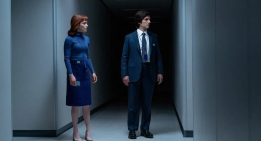Noticias
Las películas favoritas de las tres revistas más prestigiosas
La francesa Cahiers du Cinéma, la británica Sight & Sound y la estadounidense Film Comment publicaron sus títulos preferidos del año y de la década 2000-2009. Lucrecia Martel, presente en varias listas de las publicaciones.
Películas de la década 2000-2009
1- El camino de los sueños / Mulholland Drive – David Lynch
2- Elephant – Gus van Sant
3- Tropical Malady – Apichatpong Weerasethakul
4- The Host – Bong Joon-ho
5- Una historia violenta / A History of Violence – David Cronenberg
6- Cous cous / The Secret of the Grain – Abdelatif Kechiche
7- Al este de las vías / West of the Tracks – Wang Bing
8- Guerra de los Mundos / War of the Worlds – Steven Spielberg
9- El Nuevo Mundo / The New World – Terrence Malick
10- Ten – Abbas Kiarostami
Películas de 2009
1. Les Herbes folles, de Alain Resnais
2. Vincere, de Marco Bellochio
3. Bastardos sin gloria, de Quentin Tarantino
4. Gran Torino, de Clint Eastwood
5. Singularités d’une jeune fille blonde, de Manoel de Oliveira
6. Tetro, de Francis Ford Coppola
7. The Hurt Locker, de Kathryn Bigelow
8. Le Roi de l’évasion, de Alain Guiraudie
9. Tokyo Sonata, de Kiyoshi Kurosawa
10. Hadewijch, de Bruno Dumont
Sight & Sound
Películas de la década 2000-2009 (en orden alfabético)
Adaptation – Spike Jonze
Battle in Heaven – Carlos Reygadas
The Beat That My Heart Skipped – Jacques Audiard
The Bourne Ultimatum – Paul Greengrass
Caché – Michael Haneke
Colossal Youth – Pedro Costa
The Death of Mr. Lazarescu – Cristi Piu
Éloge de l’amour – Jean-Luc Godard
The Five Obstructions – Lars von Trier y Jorgen Leth
The Gleaners and I – Agnès Varda
La niña santa / The Holy Girl – Lucrecia Martel
Inland Empire – David Lynch
In the Mood for Love – Wong Kar-Wai
Memories of Murder – Bong Joon-ho
Platform – Jia Zhangke
Russian Ark – Aleksandr Sokurov
The Son – Jean-Pierre and Luc Dardenne
Spirited Away – Hayao Miyazaki
Talk to Her – Pedro Almodovar
Ten – Abbas Kiarostami
There Will Be Blood – Paul Thomas Anderson
35 Shots of Rum – Claire Denis
Touching the Void – Kevin Macdonald
Tropical Malady – Apichatpong Weerasethakul
United Red Army – Wakamatsu Koji
Uzak – Nuri Bilge Ceylan
Waiting for Happiness – Abderramane Sissako
Werckmeister Harmonies – Béla Tarr y Agnes Hranitzky
Workingman’s Death – Michael Glawogger
Yi Yi – Edward Yang
Películas de 2009
1 A Prophet (Un Prophète) (Jacques Audiard, France/Italy)
2 The Hurt Locker (Kathryn Bigelow, USA)
2 35 Shots of Rum (35 rhums) (Claire Denis, France/Germany)
4 The White Ribbon (Das Weisse Band) (Michael Haneke, Germany/Austria/France/Italy)
5 Let the Right One In (Låt den rätte komma in) (Tomas Alfredson, Sweden/Norway)
6 Up (Pete Docter, USA)
6 White Material (Claire Denis, France)
8 Bright Star (Jane Campion, UK/Australia)
8 Antichrist (Lars von Trier, Denmark/Germany/France/Sweden/Italy/Poland/Belgium)
10 Inglourious Basterds (Quentin Tarantino, USA/Germany)
Film Comment
Películas de la década
1. Mulholland Drive David Lynch, U.S., 2001 2808 points
2. In the Mood for Love Wong Kar Wai, Hong Kong, 2000 2687
3. Yi Yi Edward Yang, Taiwan/Japan, 2000 1833
4. Syndromes and a Century Apichatpong Weerasethakul, Thailand/Austria/France, 2006 1738
5. There Will Be Blood P.T. Anderson, U.S., 2007 1664
6. The Death of Mr. Lazarescu Cristi Puiu, Romania, 2005 1407
7. A History of Violence David Cronenberg, U.S./Canada, 2005 1303
8. Tropical Malady Apichatpong Weerasethakul, France/Thailand/Italy/Germany, 2004 1301
9. 4 Months, 3 Weeks and 2 Days Cristi Mungiu, Romania, 2007 1249
10. The New World Terrence Malick, U.S., 2005 1223
11. Platform Jia Zhangke, Hong Kong/Japan/France, 2000 1206
12. Zodiac David Fincher, U.S., 2007 1143
13. The Intruder Claire Denis, France, 2004 1110
14. The Son Jean-Pierre & Luc Dardenne, Belgium/France, 2002 1089
15. Dogville Lars von Trier, Denmark/Sweden/France/U.K./Germany/Netherlands, 2003 1084
16. Caché Michael Haneke, France/Austria/Germany/Italy, 2005 1083
17. Kings and Queen Arnaud Desplechin, France, 2005 1080
18. Elephant Gus Van Sant, U.S., 2003 1036
19. The Royal Tenenbaums Wes Anderson, U.S., 2001 1007
20. Before Sunset Richard Linklater, U.S., 2004 1005
21. Spirited Away Hayao Miyazaki, Japan, 2001 1000
22. The Gleaners and I Agnès Varda, France, 2000 985
23. Goodbye, Dragon Inn Tsai Ming-liang, Taiwan, 2003 975
24. The World Jia Zhangke, China/Japan/France, 2004 974
25. Talk to Her Pedro Almodóvar, Spain, 2002 973
26. Inland Empire David Lynch, U.S./France/Poland, 2006 960
27. Still Life Jia Zhangke, China/Hong Kong, 2006 934
28. Colossal Youth Pedro Costa, France/Portugal/Switzerland, 2006 929
29. Russian Ark Alexander Sokurov, Russia/Germany, 2002 870
30. A.I.: Artificial Intelligence Steven Spielberg, U.S., 2001 850
31. In Praise of Love Jean-Luc Godard France/Switzerland 2001 834
32. Eternal Sunshine of the Spotless Mind Michel Gondry, U.S., 2004 832
33. No Country for Old Men Joel & Ethan Coen, U.S., 2007 791
34. Werckmeister Harmonies Béla Tarr, Hungary/Italy/Germany/France, 2000 778
35. Grizzly Man Werner Herzog, U.S./Canada, 2005 777
36. Three Times Hou Hsiao-hsien, Taiwan, 2005 767
37. Café Lumière Hou Hsiao-hsien, Japan/Taiwan, 2003 761
38. Regular Lovers Philippe Garrel, France, 2005 759
39. Blissfully Yours Apichatpong Weerasethakul, Thailand/France, 2002 713
40. I’m Not There Todd Haynes, U.S./Germany, 2007 703
41. 2046 Wong Kar Wai, China/Hong Kong/France, 2005 700
42. In Vanda’s Room Pedro Costa, Portugal/Germany/Switzerland, 2000 654
43. Los Angeles Plays Itself Thom Andersen, U.S., 2003 649
44. Millennium Mambo Hou Hsiao-hsien, France/U.S./Spain/Greece, 2001 636
45. La Commune (Paris, 1871) Peter Watkins, France, 2000 632
46. The Hurt Locker Kathryn Bigelow, U.S., 2009 623
47. Million Dollar Baby Clint Eastwood, U.S., 2004 607
48. What Time Is It There? Tsai Ming-liang, Taiwan/France, 2001 600
49. demonlover Olivier Assayas, France, 2002 583
50. La mujer sin cabeza / The Headless Woman Lucrecia Martel, Argentina/Spain/France/Italy, 2009 581
51. La Captive Chantal Akerman, France/Belgium, 2000 580
52. Esther Kahn Arnaud Desplechin, France/U.K., 2000 579
53. Notre musique Jean-Luc Godard, France/Switzerland, 2004 562
54. Distant Nuri Bilge Ceylan, Turkey, 2002 559
55. Saraband Ingmar Bergman, Sweden, 2003 553
56. La niña santa / The Holy Girl Lucrecia Martel, Argentina/Italy/Netherlands/Spain, 2004 550
57. Y tu mamá también Alfonso Cuarón, Mexico, 2001 537
58. Brokeback Mountain Ang Lee, U.S., 2005 537
59. Children of Men Alfonso Cuarón, Japan/U.K./U.S., 2006 537
60. Ten Abbas Kiarostami, France/Iran/U.S., 2002 527
61. Silent Light Carlos Reygadas, Mexico/France/Netherlands, 2007 527
62. La ciénaga Lucrecia Martel, Argentina/Spain, 2001 511
63. L’Enfant Jean-Pierre & Luc Dardenne, Belgium/France, 2005 511
64. Star Spangled to Death Ken Jacobs, U.S., 2004 508
65. Flight of the Red Balloon Hou Hsiao-hsien, Taiwan/France, 2008 498
66. RR James Benning, U.S., 2007 491
67. The House of Mirth Terence Davies, U.K./France/Germany/U.S., 2000 484
68. 25th Hour Spike Lee, U.S. 2002 469
69. 35 Shots of Rum Claire Denis, France/Germany, 2008 460
70. Summer Hours Olivier Assayas, France, 2009 453
71. The Host Bong Joon-ho, South Korea, 2007 441
72. Adaptation Spike Jonze, U.S., 2002 438
73. Lost in Translation Sofia Coppola, U.S./Japan, 2003 435
74. Gerry Gus Van Sant, U.S., 2002 433
75. Private Fears in Public Places Alain Resnais, France/Italy, 2006 430
76. My Winnipeg Guy Maddin, Canada, 2007 430
77. Punch-Drunk Love P.T. Anderson, U.S., 2002 426
78. Fat Girl Catherine Breillat, France/Italy, 2001 422
79. The Departed Martin Scorsese, U.S./Hong Kong, 2006 422
80. Far from Heaven Todd Haynes, U.S./France, 2002 421
81. Donnie Darko Richard Kelly, U.S., 2001 413
82. Moolaadé Ousmane Sembene, Burkina Faso/Morocco/Tunisia/Cameroon/France, 2004 410
83. Woman on the Beach Hong Sang-soo, South Korea, 2006 407
84. Memories of Murder Bong Joon-ho, South Korea, 2003 405
85. West of the Tracks Wang Bing, China, 2003 398
86. Wendy and Lucy Kelly Reichardt, U.S., 2008 395
87. Trouble Every Day Claire Denis, France/Germany/Japan, 2001 390
88. Femme Fatale Brian De Palma, U.S./France, 2002 386
89. Songs from the Second Floor Roy Andersson, Sweden, 2000 386
90. Letters from Iwo Jima Clint Eastwood, U.S., 2006 379
91. Gran Torino Clint Eastwood, U.S., 2008 375
92. The Assassination of Jesse James by the Coward Robert Ford Andrew Dominik, U.S., 2007 374
93. Last Days Gus Van Sant, U.S., 2005 368
94. The Man Without a Past Aki Kaurismäki, Finland/Germany/France, 2002 368
95. When the Levees Broke Spike Lee, U.S. 2006 360
96. The Best of Youth Marco Tullio Giordana, Italy, 2003 358
97. Turning Gate Hong Sang-soo, South Korea 2002 356
98. 24 City Jia Zhangke, China/Hong Kong/Japan, 2008 352
99. In the City of Sylvia José Luis Guerín, Spain/France, 2007 352
100. The White Ribbon Michael Haneke, Austria/Germany/France/Italy, 2009 348
Películas de 2009
1. The Hurt Locker Kathryn Bigelow, U.S.
2. La mujer sin cabeza / The Headless Woman Lucrecia Martel, Argentina/Spain/France/Italy
3. Las horas del verano / Summer Hours Olivier Assayas, France
4. 35 Shots of Rum Claire Denis, France/Germany
5. Fantastic Mr. Fox Wes Anderson, U.S.
6. Police, Adjective Corneliu Porumboiu, Romania
7. Bastardos sin gloria / Inglourious Basterds Quentin Tarantino, U.S./Germany
8. Un hombre serio / A Serious Man Joel & Ethan Coen, U.S./U.K./France
9. The Beaches of Agnès Agnès Varda, France
10. El silencio de Lorna / Lorna's Silence Jean-Pierre & Luc Dardenne, Belgium/France/Italy/Germany
11. 24 City Jia Zhangke, China/Hong Kong/Japan
12. La cinta blanca / The White Ribbon Michael Haneke, Austria/Germany/France/Italy
13. The Limits of Control Jim Jarmusch, U.S./Japan
14. El sol / The Sun Aleksandr Sokurov, Russia/Italy/Switzerland/France
15. Bright Star Jane Campion, U.K./Australia/France
16. Los amantes / Two Lovers James Gray, U.S.
17. In the Loop Armando Iannucci, U.K.
18. Tulpan Sergey Dvortsevoy, Germany/Switzerland/Kazakhstan/Russia/Poland
19. Coraline y la puerta secreta Henry Selick, U.S.
20. Antichrist Lars von Trier, Denmark/Germany/France/Sweden/Italy/Poland
Películas que importaron en 2009
Blind Pig Wants to Fly/Avatar
What exactly, you might ask, do these two films have in common? Isn’t that just like Film Comment, finding a clever link between a $230 million virtual 3-D epic about blue humanoids and a no-budget Indonesian whatsit likened by its creator to a mosaic “built from shattered pieces of colored glass. Delicate, fragile, beautiful”? Well, guess what? There is no link, and they have absolutely nothing in common. These two wildly divergent items and their attendant circumstances (of inspiration, production, exhibition, etc.) offer a dramatic illustration of the ever-widening gulf between commercial and independent filmmaking. Ten years ago, Abel Ferrara mused that movies would just keep getting “bigger and bigger and smaller and smaller.” He had no idea. The divide between big and small has become so great that they now effectively occupy two distinct realms. In another decade, the mingling of commerce and art will be a distant memory.—Kent Jones
Star Trek/Terminator Salvation
Franchise filmmaking: a pestilence inflicted upon us by soulless corporate groupthink? James Bond, Hope and Crosby’s Road pictures, Japan’s Zatoichi samurai movies, and over 40 Charlie Chan films say otherwise. It’s safe to say that Hollywood’s current obsession with this business model is here to stay, and sure, the results can be ugly: the “reboot” of the Terminator series didn’t take because—well, would you buy a used cyborg from a guy who goes by the name McG, and whose claim to fame is a pair of Charlie’s Angels movies? By contrast, Star Trek is the apotheosis of franchise cinema: genuinely thrilling, top-notch in every respect, and made with real heart, it’s no coincidence that it took J.J. Abrams, a TV guy who truly understands his audience, to re-energize this TV-derived property.—Gavin Smith
The Limits of Control
Like a postmodern Beat the Devil, Jarmusch’s postcard-sized daydream touched on the essentially arbitrary, capricious nature of movies. Evoking the limits of artistic as well as social control, it acknowledged in sly, oddly moving ways the fine cinematic line between meaning and nothingness. The elided plot, stock figures, and crypto-philosophical dialogue were open-ended whims—wandering conceits held together by precise visual tonalities, ambient acting, everyday rituals. Inviting you to read as much or as little into it as you desired, the film was the antithesis of the superego-driven, White Ribbon model of Significance über Alles—an eloquently still travelogue of ephemeral landscapes.—Howard Hampton
Precious: Based on the Novel Push by Sapphire
Like Thelma & Louise, the Western/ road-movie in which sisterhood turned genre upside down, twisting the knickers of the positive-role-model crowd, Precious—a horror movie in which a young woman who sees herself as a monster survives and thrives thanks to the intervention of a disparate bunch of sisters—is the object of a similarly narrow and reactionary attack. What’s on the screen isn’t realism, it’s Precious’s own nightmare, writ gargantuan; how she emerges from it is the stuff of myth, or at least, of the feminist movie of the year.—Amy Taubin
Invictus
it’s easy to imagine alternate versions of this film, each more dutiful than the next. At one time, the story of Nelson Mandela and the Springboks rugby team would have gotten the Attenborough treatment. A little further down the road, it probably would have been listed on IMDb for a couple of years as “Untitled Steven Spielberg Project.” Fifteen years after the end of apartheid, it has been realized by one of our most consistently surprising directors with an ease and grace that are all but unheard of in cinematic chronicles of Official History. What would surely have been yet another excuse for the soon-to-be-extinct Quote Whores to demonstrate their craft turned out to be a deft, quietly observant study of political strategizing. Unsurprisingly, it also turned out to be another Clint Eastwood movie with a lonely old hero and an unlikely younger protégé at its center. And a lovely Clint Eastwood movie at that.—Kent Jones
A Serious Man
An homage to that postwar mid-century interval when Jews felt secure enough to generate multiple literary excoriations of hypocrisy, lampoons of the community, and violent exposures of the American Dream as a cost-values scam at retail prices. For a variety of reasons—the zeitgeist went anti-Zionist, the genre was either played out or circumcised by Woody Allen—there’s been no meaningful Jewish self-critique in decades. Until now, that is, as the Coen Brothers nail Midwestern Reform Judaism to the wall. Not since Philip Roth has anyone in the arts so thoroughly and convincingly eviscerated the rabbinate as just one more manifestation of American charlatanism. When my father was dying, he rallied before slipping into a coma and said, “No rabbis!” A Serious Man explains why.—Harlan Jacobson
Transformers: Revenge of the Fallen
Okay, so a state-of-the-art digital spectacle in which the entire might of the U.S. military takes on giant extraterrestrial robots bent on Earth’s destruction sounds kinda cool. But the unprecedented level of cooperation and sheer dollar value of the hardware put at the filmmakers’ disposal by all branches of the armed forces effectively makes this sorry sequel a co-production between Hollywood and the Defense Department. Climaxing with a showdown in the Middle East, the film’s wholehearted glorification of the war machine makes it the most expensive military recruitment film of all time, smuggled inside a story inspired by a range of children’s toys—in short, an act of monumental repugnance. Take a bow, Michael Bay: Hollywood’s number-one war enabler.—Gavin Smith
Fantastic Mr. Fox/Where the Wild Things Are
Two kids movies with a difference, both imaginative expansions (rather than betrayals) of enshrined classics with the under-10 set, both made by card-carrying auteurs who recently turned 40. With the notable exception of the Pixar output, we have been overrun in recent years with market-research-driven horrors, not so much made for children as targeted at them, with “vintage” pop culture references and fart gags slotted in for parents and teenage siblings. That Anderson and Jonze’s movies were lovingly and impeccably crafted came as no more a surprise than the emotional breadth of their respective films. What possibly did come as a surprise to adults and kids unacquainted with the filmmakers’ oeuvres was the distinctive manner with which each film saw childhood as a point on a continuum rather than a neverland of joyful irresponsibility punctuated by the occasional Lesson Learned. If Anderson finally made the better movie, it’s probably because he’s as true to himself as he is to his source material.—Kent Jones
(500) Days of Summer/The Hangover/Paranormal Activity
is it any wonder that, in a year when American women directed more features than ever, the three biggest “surprise” hits predictably pegged the girlfriend as Pure Evil? (500) Days of Summer begins by comically dedicating itself to the director’s “bitch” of an ex, presuming the core audience can relate. The Hangover, a cocktail of hate, is barely even getting buzzed before establishing one bachelor partyer’s significant other as a consummate cunt. And Paranormal’s domestic disturbance is no more supernatural than that of a chick taking possession of “your” house. Note to Marc Webb, Todd Phillips, and Oren Peli: Kathryn Bigelow is a more muscular director than all of you combined.—Rob Nelson
19 descubrimientos de 2009
Beetle Queen Conquers Tokyo
(Jessica Oreck, U.S./Japan)
The sense of wonder that pervades Jessica Oreck’s debut film owes more to David Attenborough than the dull-thud misanthropy of Werner Herzog. A kaleidoscope view of Japan’s past, through the traditions and customs that survive to the present, Beetle Queen bristles with kinetic energy. Lightning bugs become flares in the night as the micro-world of insects is portrayed as an exalted and adventurous place. Boasting beautifully accentuated sound design, it’s a film to be heard as well as seen.—Michael Chaiken
Bernadette
(Duncan Campbell, Ireland)
In this 37-minute film essay, Campbell uses 16mm archival images to deconstruct the figure of Bernadette Devlin, the charismatic socialist activist from Northern Ireland who became the youngest member of the British Parliament in 1969 at age 21. By exploring Devlin’s face and words, Campbell evokes a form of political idealism and compromise that today seems lost, while the deliberately choppy and haphazard editing reveals the limits and perversity of media discourse.—Manuel Yáñez-Murillo
The Blacks
(Zvonimir Juric & Goran Devic, Croatia)
A Croatian paramilitary death squad self-destructs: soldiers out for revenge suddenly start shooting at each other; things fall apart. A No Exit experience directed with rigor and precision down to the smallest detail, camera movement, gesture, even the pronunciation of every word—it’s perfection pure and simple. Tough, unflinching, and fearless.—Olaf Möller
The Blue Generation
(Garin Nugroho, Indonesia)
in an era in which rock and street dance pulse with the rhythms of a narcissistic culture, an experimental documentary like The Blue Generation must be regarded as a revolutionary object. How else can one label this collaboration between an independent auteur (Nugroho), a popular Indonesian rock band (Slank), and a group of dancers? Their goal: to exorcise the memory of recent tragedy from their country, and then quickly set the stage for peace and unity.—Manuel Yáñez-Murillo
Burrowing
(Fredrik Wenzel & Henrik Hellström, Sweden)
The first feature by two thirtysomething Swedes is a weird one: an Astrid Lindgren story, as re-told by Elfriede Jelinek. At first, it seems dangerously close to the type of “haunting ambient installation” favored by the Scandinavian art world. But its passively roving look at affluent suburban brain-death soon mutates into a much more engaging—and socially scary—setup: a child sleuth’s midsummer run-in with demons. Seventy-six minutes of digital film do not a career make, but these two newcomers are probably worth betting on.—Alexander Horwath
Contact High
(Michael Glawogger, Austria)
The strangest of beasts: a big-budget avant-garde entertainment. Detailing the misadventures of two aspiring hot-dog entrepreneurs who unwittingly find themselves on a psychedelic road trip, the film resembles a Hunter S. Thompson/Kurt Vonnegut version of a Louis de Funès film with a touch of Danny Leiner. On first viewing, it plays like an amusement ride full of idiosyncratic moves, surprising twists, and stunning visual ideas; with repeat viewings, one discovers the film’s riches, its intricate structure and its multitude of layers and subtexts. The film brings order to a chaos that includes a commotion over the contents of a mysterious bag, drugs, hot “Go-Go” dogs, a shrunken hotel room, the Polish pig police, and a Mexican albino.—Olaf Möller
Corneille-Brecht
(Jean-Marie Straub & Cornelia Geiser, France)
Co-director CorneliaGgeiser sits by a window on an easy chair reading aloud a few verses by Corneille, then a somewhat longer excerpt from Brecht—each writer referencing Rome but really condemning injustice in his own era. The dead are mourned and their memories evoked. Straight cuts, sharp breaks in lighting continuity, and a few costume changes—and that’s it.—Olaf Möller
Double Take
(Johan Grimonprez, Belgium/Netherlands/Germany)
Working up a brisk assemblage of TV and newsreel material, artist/filmmaker Grimonprez muses on Hitchcock’s persona and humor, reading his films of the Fifties and Sixties against the climate of atomic-era political anxiety. Hitchcock’s preoccupation with doubling turns out to recur obsessively in the maestro’s jokey television intros; the theme is further expanded in an apocryphal story borrowed from Borges. Thought-provoking and hugely entertaining, not least in its extensive use of Folgers Coffee ads.—Jonathan Romney
The Feature
(Michel Auder, U.S.)
Compiling four decades’ worth of diaristic video into a fiction masquerading as documentary—and vice versa—the magnum opus of artist and filmmaker Michel Auder has much to say about marriage, fatherhood, and the vicissitudes of old-school bohemia. In plumbing his own memory bank, Auder archives the biography of video itself, returning us to the bleary, low-res childhood of the medium.—Nathan Lee
Film Is a Girl & a Gun
(Gustav Deutsch, Austria)
The latest installment of Gustav Deutsch’s epic recombination of archival film footage creates a grand meta-narrative, “a drama in five acts”: Genesis, Paradise, Eros, Thanatos, Symposium. Deutsch deploys texts from Hesiod, Sappho, and Plato, but the shadow of Freud is omnipresent in these struggles between men and women, chaos and order, life and death. Who knew that cinema was constantly writing and rewriting Beyond the Pleasure Principle?—Thom Andersen
The Haunted World of El Superbeasto
(Rob Zombie, U.S.)
in which Murders in the Rue Morgue is revamped for Rob Zombie fans (who already know that The Devil’s Rejects was the best American horror film of the last 20 years). An X-rated neo–Fritz the Cat for the post-Simpsons generation, Zombie and collaborator-star Tom Papa’s El Superbeasto continues the director’s fascination with masks (cf. his much-maligned Halloween diptych), the latest one belonging to the libidinous and loquacious luchador upon whom the fate of the world depends, if only he can tear himself away from that delicious plate of hot wings. Cartoons aren’t just for kids anymore . . . again.—Chuck Stephens
Helsinki, Forever
(Peter von Bagh, Finland)
This Marker-esque essay by the former head of the Finnish Film Archive relates a multifaceted history of Helsinki (and, more incidentally, Finland, including its cinema and pop music), with beautiful clips and paintings, and narration by three voices, one of them von Bagh’s. We are introduced to the best ever Finnish camera movement and the best Finnish musical, and invited to browse through diverse neighborhoods and eras; throughout, we can’t help but marvel how much spectacular footage comes from this city.—Jonathan Rosenbaum
It Felt Like a Kiss
(Adam Curtis, U.K.)
The latest installment in Adam Curtis’s ongoing 20th-century media-meltdown, It Felt Like A Kiss expands Curtis’s dazzling found-footage mastery into the third dimension—especially when seen in all its “olfactory-audiovisual promenade-style theatre production” glory “performed” as a multi-environment installation in Manchester last July. Curtis is the BBC’s answer to Craig Baldwin. Though the film’s top-billed stars are Rock Hudson, Lee Harvey Oswald, and Saddam Hussein, Curtis’s not-so-covert mission is mostly interested in the ways that political power and media manipulation over the last half-century, particularly for women (as “embodied” by Jackie Kennedy, Mia Farrow, and Tina Turner), have come to feel a whole lot more like a hit than a kiss.—Chuck Stephens
Lowlands
(Peter Thompson, U.S.)
“Exploring the effects of war upon domestic and creative life” via the wife and widow of Vermeer, and culminating in one of her dreams (in the form of a masque and oratorio), this 59-minute marvel by Chicago’s best (and least-known) filmmaker (see the Fall 2009 Film Quarterly for more details) also delves into 1996 Bosnian war crimes, Vermeer’s paintings, and startling rhyme effects between the two.—Jonathan Rosenbaum
Lunch Break
(Sharon Lockhart, U.S.)
the premise is simple: document the interior of a shipyard corridor, where workers spend their lunch breaks, by means of a single forward tracking shot. It’s a gesture that combines a primitive notion of capture that dates back to the Lumière Brothers with advanced cinematic manipulation. The shot is stretched out to 80 minutes through super-slow motion, evoking a sensual, mysterious, and hypnotic “epic of weightlessness” not unlike the pop processions of Wes Anderson. Call it 2009: A Proletarian Odyssey.—Manuel Yáñez-Murillo
The Old School of Capitalism
(Zelimir Zilnik, Serbia)
A heady yet lucid mix of documentary and fiction created during the first wave of mass strikes in Serbia since the advent of capitalism. It’s cinema verité meets the Western meets noir, shot fast and loose, and featuring a number of scenes in which the “characters” (many of them real-life activists) and actual strikers interact. Stellar partisan filmmaking.—Olaf Möller
Plato’s Atlantis
(Alexander McQueen, U.K.)
For his Spring-Summer 2010 collection, fashion designer Alexander McQueen staged an exquisitely sinister trance film featuring an elite tribe of rapt, ineffably empowered avant-amphibious glamazons. Advancing on couture lobster claws with 10-inch heels, their bodies reconstituted through digitally printed dresses of flabbergasting complexity, the models circulated a stage mounted with two remote-control robotic arms relaying their images to a massive video screen. Broadcast live at SHOWstudio.com, Plato’s Atlantis was the year’s most chilling and hypnotic science fiction.—Nathan Lee
The Storm
(Kazim Öz, Turkey)
A young Kurd comes to town to study—only to suffer the injustices that Turkey’s cultural majority has in store for him, culminating in persecution and torture by the state. Öz’s film is a social-realist epic (with modernist touches) addressing the rise and self-realization of the Kurdish extreme left, and the ways in which youth go underground, taking their reasons, passions, and hopes with them.—Olaf Möller
Symbol
(Hitoshi Matsumoto, Japan)
a man dressed in colorful pajamas enters a Kafka-esque nightmare in the interior of an enormous, empty, white-walled room from which there is no escape. The man is played by Hitoshi Matsumoto, a stand-up comic cum filmmaker à la Kitano, and the man behind the caustic and crazy Big Man Japan (07). Here, he refines his control of mise en scène and reaffirms his sense of humor—from the deadpan to the histrionic—to construct a monumental farce about existential angst and religion.—Manuel Yáñez-Murillo
COMENTARIOS
DEJÁ TU COMENTARIO



NOTICIAS ANTERIORES
Del 19 de julio al 3 de agosto se proyectan en el Cine York (Juan Bautista Alberdi 895, Olivos), con entrada libre (por orden de llegada), films como El aura, Nueve Reinas, Un Oso Rojo, Silvia Prieto, Pizza, birra, faso, El estudiante, Rojo, Cuando acecha la maldad, Simón de la montaña y Alemania.
Del 23 al 27 de julio se proyectarán, entre otras películas, Sauvages y My Life as a Zucchini, de Claude Barras; L'Histoire de Monsieur Vieux, clásico de animación con musicalización en vivo a cargo de Axel Krygier.
El responsable de la muestra ¡Esto es Historieta! adelanta lo mejor de la inminente segunda edición, habla de las relaciones entre cómic y películas, de los tributos a Héctor Germán Oesterheld y Fabián "Polo" Polosecki; del fenómeno de Hora Cero y la nueva cinefilia, de su traumática salida como director artístico del Festival de Mar del Plata en 2024, de la movida de Contracampo (ahora Fuera de Campo) y de la situación actual en el INCAA en particular y en el cine argentino en general.
-Severance sumó 27 candidaturas, seguida por El Pingüino con 24, The Studio con 23 y The White Lotus también con 23.
-HBO Max consiguió 142 nominaciones seguida por Netflix con 121 y Apple TV+ con 81.
-La ceremonia de la 77ª edición será el domingo 14 de septiembre con la conducción de Nate Bargatze.












¿Tanto gustó la de Tarantino, que las tres revistas la ponen entre lo mejor de 2009?<br /> Tengo que hacerme ver.
Poco serio el copy/paste.
Murió Eric Rohmer. <br /> <br /> Nos queda su cine! Se fue otro grande.
Tetro entre las mejores? Mamita querida, qué mal anda el mundo!
Para mi gusto Femme Fatale está demasiado abajo, yo estoy convencido de que es la mejor pelicula de la década. Es una lástima que entre cien no figure ninguna de las dos enormes peliculas de Bielinsky,que son mejores que unas cuantas de la lista.<br /> War of the worlds en la lista de Cahiers no lo puedo creer.
no sabía que Manuel Yañez Murillo -un "pollo" de Otros cines- también escribía en Film Comment. Se va para arriba el hincha del Barcelona!